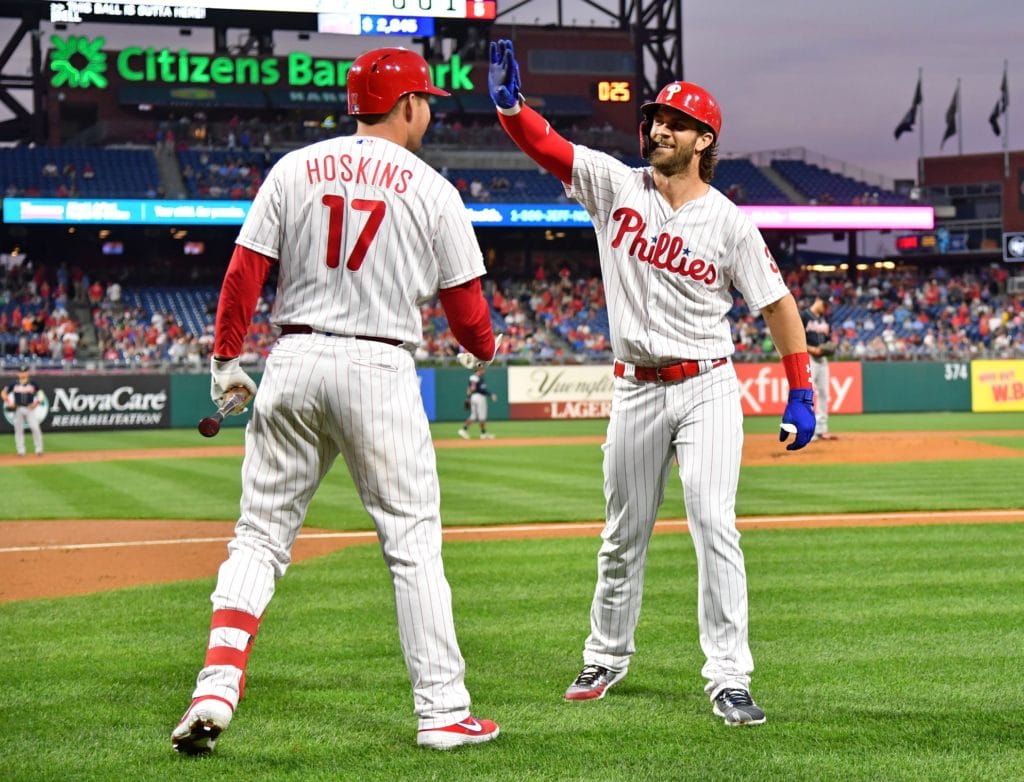Ad Disclosure
Thoughts on Baseball’s Possible Return and What It Means for Phils
By Bob Wankel
Published:

MLB owners approved a plan earlier today for the parameters of a possible 2020 baseball season.
Great. Baseball and fireworks in early July. See you there…right?
If only it were that simple.
While the science and safety concerns at the heart of coronavirus pandemic should be the primary roadblock to a Major League Baseball season, those obstacles are currently superseded by a more traditional source of angst.
As it turns out, cash still rules everything around us.
To simplify the complexities of baseball’s economic structure, one muddied by ambiguity regarding teams’ various revenue streams, MLB and the MLB Players Association will meet tomorrow (virtually) to begin discussing how to split up the league’s reduced 2020 earnings.
According to ESPN’s Jeff Passan, owners want a 50/50 revenue split with players, while players are likely to decline such a plan. Instead, it’s expected the MLBPA will instead push the earlier agreement between the two sides that provides players with a prorated portion of scheduled salaries.
Gate revenue (which includes concessions and merchandise) accounts for less of teams’ total revenue streams than it has in the past, and the numbers vary by team, but it remains a significant part of the total earnings pie.
Ultimately, league owners will want the players to absorb more of the hit beyond prorated salaries in the event gates stay closed to the public.
Will the union go for it? Will owners back down if met with resistance?
Yes, to some combination of the above. I think. Maybe?
It’s 2020, and if this year has taught us anything at all, it’s that nothing should be taken for granted. Conventional wisdom would suggest that baseball, a game that has lagged in different popularity metrics in recent years, simply has to capitalize on a beyond obvious opportunity to emerge for a country in dire need of normalcy.
Then again, conventional wisdom didn’t include hitting a pizza box with Lysol or spending Mother’s Day stationed 25 feet away on my parents’ lawn before 2020, so I’m not sure how much we can really rely on it here.
Beginning tomorrow, we should develop a sense of whether these financial hurdles will eventually be cleared, leaving only the end boss of science standing in the way of baseball’s return.
Some other notes on what a 2020 season could look like for the Phillies:
- There’s going to be a DH for National League teams. I love a pitcher that’s hitting .088 up there flailing away like an asshole at sliders in the dirt with two runners on and two outs in the fourth inning as much as anyone, but this change has felt inevitable for awhile now. It also feels permanent.
- I would bet money that Jay Bruce and Rhys Hoskins lead the team in plate appearances as the DH.
- There won’t be any fans in the stands to begin the season, and I doubt there will be at any point. How might that impact the Phillies? Why don’t we just take a look at how they have played in Miami in recent seasons. The Marlins averaged an embarrassing 10,015 fans in 2018 and 2019, and the Phillies went 7-11 against them on the road. That’s not very good, and it’s even worse when you consider Miami was a combined 24 games under .500 at home in those two seasons.
- Perhaps the much talked about professionalism brought by Joe Girardi and his staff will help rectify the lulls we saw all too frequently last season.
- An 82-game season has various implications for the Phillies.
- To begin, there’s less time for a team to find its level. Nobody would argue that the 2018 and 2019 teams were powerhouses. Still, the 2018 Phillies were in first place on August 11 at 65-51, while at 38-29, the 2019 team held a share of first place on June 11. A shorter season could lead to chaos and parity. If you thought the Phillies would fall short in a 162-game marathon, then maybe they can repeat a similar early sprint of recent seasons past and make things weird.
- On the other hand, teams may be a bit more focused early on knowing that each game carries more weight. Plus, with more emphasis on division play, not only should teams be a bit more dialed in, the NL East figures to be a tough division.
- At least there’s going 14 teams in the postseason.
- With a 14-team postseason, there should be no excuses for this team. The Phillies have to find a way to make the playoffs for the first time since 2011.
- From an on-field perspective, the shortened season (and probable lack of minor league baseball) means that we should see top prospects Alec Bohm and Spencer Howard if and when the season starts. My sense is that Bohm could see meaningful action early, including at first base, while I would expect the team to remain extremely cautious with Howard.
- Give me the Phillies and Mets at Citizens Bank Park on July 4. America.
Bob Wankel covers the Phillies for Crossing Broad. He is also the Vice President of Sports Betting Content at SportRadar. On Twitter: @Bob_Wankel E-mail: b.wankel@sportradar.com